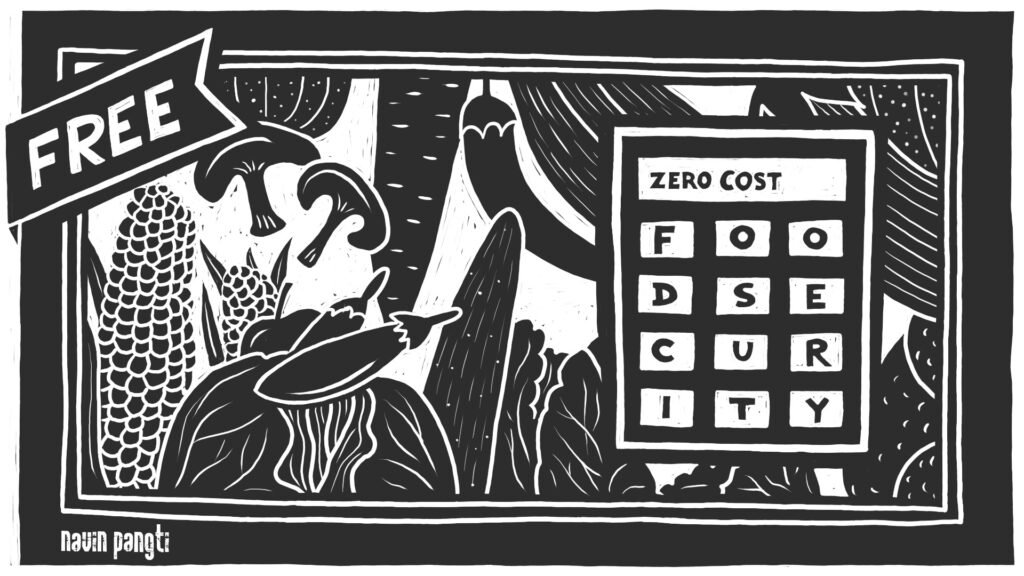Zero cost initiatives towards food security
The discourse on food security is often hijacked by issues like production efficiency, technology, infrastructure, supply chain, etc. I wonder if we are deliberately ignoring the first few steps that cost us nothing.
Most advocacy groups, policy makers, industry experts, bureaucrats, influencers, etc. talk about encouraging loans, supporting small-scale farmers and trade associations, creation of marketing boards, farmer-subsidy programmes, strategic import duties, investments in infrastructure by governments and the private sector, capacity building and what not. Most of these tools have been around for a while. And yet nothing much happened. To add insult to injury, ‘failures’ are analysed by experts and consulting firms, only to reaffirm institutional faith on these interventions. The machinery is tweaked a bit and rolled out again with greater zeal. The cycle continues.
Ideally all these interventions and their outcomes should be ‘honestly’ discussed with various stakeholders. There should be a concerted effort to identify root causes of our failures. But that does not happen. I think one of the main reasons is that ‘cash’ needs to keep flowing. Instead of actual outcome, the cash input and its circulation has become the measure of work done. These investments not only add up to the GDP (Gross Domestic Product), but also feed the beast called systemic corruption.
While doing ‘something’ has a cost attribute that leads towards debt economy, doing ‘nothing’ is almost free of cost, or may have a small or negligible cost attribute. Here, doing ‘nothing’ means acts of omission which can ‘create’ something viable and sustainable!

Presented below are three zero cost initiatives that can contribute immensely towards food security. Apart from ensuring food security, these baby steps also have the potential of changing the world forever.
A world of many eco-systems
Modern economics and market systems propagate centralised systems. They sell this idea under the garb of cost optimisation and quality control. But in reality, it is designed to benefit a few. In my opinion, such systems are also designed to garner more taxes, at multiple levels.
Before going any further, I think we need to understand two terms – food loss and food waste. Industry claims that the distinction it draws between the two is from a policy point of view. As per that distinction, food loss happens at the supply end while food wastage happens due to the consumers, retailers and food service providers. Frankly, I find this classification pretty confusing.
I think it would be simpler to consider all wastages that happen during or after processing /preparation of food as food waste. Everything else can be classified as food loss. What this means is that food loss is the loss that happens when food is in its raw state. I think that the distinction made by the industry is designed for investments and policies rather than identifying and plugging the holes. Obviously it clouds the vision and hampers systematic approach towards understanding and solving this problem.
Talking about food loss, a 2015 report of Waste and Resources Action Program found that a third of all the food produced in the world is never consumed. The Natural Resources Defence Council, an international non-profit environmental organization, estimates that 40% of food grown and produced in the United States each year goes uneaten. Almost 52% of fruit and vegetables are lost rather than consumed.
In the year 2017, India lost agri-produce worth over ₹92,000 crores. That was thrice the value of the agriculture budget of 2016. And here we are just talking about documented post-harvest losses. As per United Nations Development Programme, net food loss in India is nearly 40%.
Whatever be the numbers, it is fairly evident that significant amount of food is lost during harvest, grading, storage, transportation and retail. Greater the distance between the producer and the consumer, higher would be loss. This distance is not just about the physical proximity but also about number of middlemen involved. Even in a small town setting there could be 2 to 3 middlemen involved. Big cities involve many more.
The simplest way to curb this loss is to go local. Instead of depending on few large ecosystems, we need multitude of smaller ecosystems. We do not need the government to build these systems. Our purchase habits will automatically foster creation of such networks.
Local networks will also reduce the number of middlemen involved thereby benefiting the growers. From a consumer point of view, it would mean fresh and healthy food. This will also positively impact the environment as lesser resources will get consumed for storage and transportation.
The next obvious question is – how can one go local in cities like Delhi, Bombay, Chennai, etc. Instead of an answer, I have a question. Why does one need to stay in such polluted crowded filthy environments? What good does it serve?
Just like multitude of eco-systems can ensure fresh and healthy food, multitude of economic eco-systems can ensure happier and healthier lives for everyone. Few people cannot create this eco-system, but a collective will can easily move the mountains. Finally, it is all about perspectives and choices.
Recycling is good
Not generating waste is better
Recycling is desirable. Recycling is good. Recycling is needed. But we also need to realise that recycling can slow down the process of degradation but it cannot alter the reality. If we want to alter the reality, we have no option but to change our ways.
When we talk of net food loss, we usually ignore wastages. I think if we were to take food wastage into account, the net food loss and wastage figures may be overwhelming. Not much data is available on such wastages but a 2014 report states that hotels of UK alone wasted 79,000 tonnes of food. This figure can be safely multiplied a few times to tabulate food waste generated by households. The cumulative numbers can be alarming.
Food decay at consumer end is just one of the many elements that contribute to this waste. Large helpings at retail end significantly contribute to such wastage. The food habits of our children, eating patterns, etc. contribute further. Just imagine the amount of vegetable lost due to children, as well as adults, who discard the veggies after ordering a pizza called farm fresh.
In India, packaged and processed food consumption is growing at a rapid pace. Ordering cooked food or eating out is also on the rise. Obviously, food wastage too is growing at similar pace, or maybe even higher.
Apart from the above mentioned perspectives of food wastage, we also need to understand two important aspects related to this waste.
The first aspect is that preparation or processing of food consumes energy. Lot of high value ingredients get used in the process. Not to forget human effort. Thus, the cumulative economic and environmental impact of food wastage is quite high. So the next time one talks about climate change, one need to assess one’s own contribution. We need to understand that this is not just about greenhouse gas emissions all along the supply chain but also about release of gases like methane from the landfills. Food, sadly, is the one of the biggest contributors to landfills worldwide.
The second aspect is about definition of waste. Waste is not just about throwing something out. Taking something in, when we do not really need it also amounts to waste. While one may occasionally surrender to taste driven greed, a persistent behaviour would amount to wasting food through consumption. I think most of the readers know what I am talking about.
Nothing is ‘ugly’
We are slaves of our aesthetic choices. Our notion of beauty is cultivated by prevalent social norms and market forces. No wonder, we are happy to see same sized fruits, replicas of each other, lined up beautifully for sale. We also seek consistency of taste, even if the fruit taste like sweetened cardboard. We have somehow come to believe that every agricultural produce has a pre-defined shape and volume. Hence, we reject everything else that does not fit the bill.
This idea is beauty and consistency is so ingrained in our behaviour that we happily reach out for pre-pealed fruits and vegetables wrapped in cellophane. We love it when individual fruits are neatly placed inside a plastic net packaging, with each fruit labelled with a decorative sticker that announces the lineage and freshness of the agri-produce. Even when we are aware of the sheer ridiculousness of this act, we do not feel repulsed. We don’t even blink an eye.
Obviously we seem to have forgotten that every fruit and vegetable that grows does not look the same. Even the ones that grow on the same tree and ripen on the same day may not taste and feel the same. The produce that no one would buy due to its aesthetic inconsistency is called ‘ugly’ food.
Have you ever wondered what happens to such ‘ugly’ food?
Well, most of it is lost. And the numbers are pretty huge. A 2017 report from UK estimates that up to 25% of apples, 20% of onions and 13% of potatoes grown in the UK are lost because they are deemed ugly. Net loss at the farmer end due to aesthetics could be as high as 50 to 60%. The Natural Resources Defence Council report states that entire fields in USA are left un-harvested, solely due to cosmetic reasons.
While there is no specific data about such losses in India, chances are that its contribution would be pretty high. This loss may be significant during the harvest and grading stage. Most of such losses would not get accounted for as they never enter the supply chain.
Another major point of concern is that ‘ugliness’ directly impacts the diversity of seeds. In order to be aesthetically consistent, the farmers are forced to abandon traditional seeds. Lower seed diversity impacts our food security in more ways than we can ever imagine. We will discuss this issue through a separate article very soon.
***
The net impact of these three aspects on our lives and the ecosystem is overwhelming. From a consumer point of view, these issues are not just about food security but also about our relationship with food and the consumerist mind-set that often auto-drives our choices.
The good news is that to bring about change we do not really need policy interventions by the government. Chances are that many governments may not even favour these choices. Luckily, all these changes can be initiated and driven by consumers. The ball in in our court!














